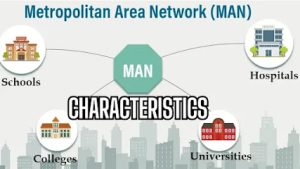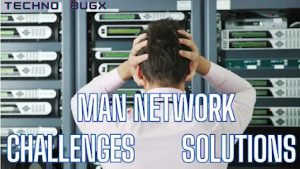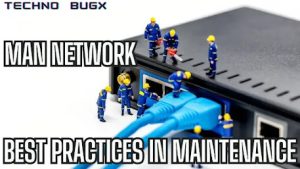Mastering Metropolitan Area Networks: Unleash the Power of MAN Technology

Metropolitan Area Networks (MANs), which link local and wide area networks to form a seamless web of connectivity throughout urban and suburban regions, play a crucial role as a bridge in the large field of networking.
This introduction clarifies the meaning, significance, and applicability of managed access networks (MANs) in modern networking, laying the groundwork for our investigation of them.
- Metropolitan Area Networks (MANs)
- Understanding Metropolitan Area Networks(MANs)
- Characteristics of MANs
- MAN Topologies
- Components andTechnologies
- Benefits of MANs
- Challenges and Solutions
- Best Practices in Maintenance
- Future Trends
- Conclusion
Metropolitan Area Networks (MANs)
A family of computer networks known as metropolitan area networks, or MANs for short, span a region that is bigger than a local area network (LAN) but smaller than a wide area network (WAN).
In short, mans are the networking infrastructure that connects the several local area networks (LANs) in a metropolitan or urban area, enabling high-speed communication and data transmission over long distances.
This kind of network mostly serves urban areas or sizable campuses, facilitating effective data transfer between various sites or buildings inside the designated metropolitan area.
In addition to standard parts like switches and routers, Mans includes a range of technologies, such as fiber optic cabling and wireless solutions.
MANs Significance and
Applicability in Contemporary Networking
The importance of MANs in the rapidly changing world of contemporary networking cannot be overemphasized.
They are the glue that keeps communication and data transfer in urban areas flowing smoothly, and their importance is evident in several ways.
Urban Connectivity:
MANs are essential to a city’s or metropolitan area’s ability to:
- Connect businesses
- Organizations
- Institutions
The operation of government agencies, businesses, and other critical services is made possible by this connectedness, which also supports urban life.
High-Speed Data Transfer:
MANs stand out as high-speed data highways in a world where the rapid interchange of data is essential. Faster data transfer rates are made possible by them, which makes them perfect for applications like:
- Cloud-based services
- Real-time data processing
- Video conferencing that require instant access to information
Scalability:
The potential of MANs to grow is another distinguishing feature. When the necessity comes, they are made to grow and adapt.
In addition to meeting expanding network demands, this scalability does so affordably, saving businesses from having to undertake extensive infrastructure renovations.
Versatile Applications:
MANs are used in a wide range of industries. MANs link data centers and branch offices in business settings, facilitating the transfer of information that is essential for cooperation and production.
MANs are used by educational institutions to guarantee that instructors and students on large campuses have access to e-learning systems and materials. MANs help telemedicine in the healthcare industry, enabling safe and effective patient care.
Metropolitan Area Networks, which support the operations of various entities and guarantee the rapid and effective movement of data, are essentially the backbone of contemporary metropolitan connectedness.
This article will go into additional detail about the parts and technology that drive MANs, as well as their practical uses, problems they encounter, and emerging developments that will likely shape their future.
Understanding (MANs)
- A network type that
connects Local Area Networks (LANs) and Wide Area Networks (WANs) is called a
Metropolitan Area Network (MAN).
- MANs provide a middle
ground between WANs, which cover vast geographic regions, and LANs, which are
limited to a single building or campus.
- They are intended to
cover a large region, such as a city or college.
- In other words, MANs allow
smooth communication across a wider area and high-speed data transfer by
connecting multiple LANs inside a city or region.
- A MAN is made up of several
different parts, including switches, routers, and optical fiber cabling.
- Together, these elements form a network that can span an entire city or sizable
campus.
- MANs topologies can be ring, bus, star, or any combination of these.
Explanation of MANs as a
Type of Network
In computer networks, metropolitan area networks, or MANs, are an essential middleman. Their intended coverage area is greater than that of a Local Area Network (LAN) but less than that of a Wide Area Network (WAN).
Within a designated metropolitan area, MANs serve as the networking backbone that links different local area networks (LANs). This makes it possible to communicate and transmit data over distances ranging from a few kilometers to tens of kilometers efficiently.
Setting MANs Apart from
Other Types of Networks (LANs and WANs)
It’s critical to differentiate MANs from other network types to understand them better. Local area networks, or LANs, are restricted to a small geographic area, usually within a single campus or building.
LANs make it easier for devices that are close to one another to communicate. Conversely, wide area networks, or WANs, cover enormous geographic areas; they frequently cut through cities, states, or even entire nations.
MANs serve both urban and suburban communities, fitting perfectly in between these two. They cover more ground than LANs, but they do not cover the long distances that WANs do. MANs are defined by this middle position.
Characteristics of MANs
Regional Coverage
A feature of MANs is their regional coverage, which includes metropolitan or urban areas. They are designed to satisfy the unique connectivity requirements of companies, colleges, and organizations that operate on sizable campuses or inside city limits.
This coverage region can vary in size, but it usually covers tens of kilometers to several square kilometers, forming a network footprint that fills in gaps between cities.
Average Transfer Rates
for Data
- A notable attribute of
MANs is their ability to transfer data at rapid speeds.
- MANs provide data
transmission speeds that balance local area networks (LANs), which are designed
for efficient local communication.
- Wide area networks
(WANs), which may encounter delays in data transfer because of extended
distances.
- This speed is necessary
to support services and apps that consume a lot of bandwidth, guaranteeing.
Important Elements and Infrastructure
- MANs infrastructure is
made up of various essential parts.
- These consist of
switches, routers, and network cabling, with fiber optic cables frequently
receiving special attention.
- Important parts of
controlling and effectively directing data flow inside a network are played by
switches and routers.
- High-speed data transport
is made possible via fiber optic cabling, which uses light signals to transfer
data.
- This infrastructure is
the foundation for MANs dependability and efficiency.
MAN Topologies
Ring Topologies
In MANs, ring topology refers to the circular connections between nodes or places. Up until it gets there, data moves around the ring. Due to its ability to handle faults and allow data to flow in both directions, this topology is well-known for its redundancy and fault tolerance.
Bus Topologies
All nodes or locations in a bus topology are connected to a single central cable. Data travels via the cable and is received at its designated location. Despite being quite straightforward, if there are problems with the central wire, the network may be disrupted.
Star Topologies
Every node in a star topology is linked to a single hub or switch. Excellent control and simple troubleshooting are made possible by this design since problems with one node do not always affect others. Comparatively speaking to other topologies, it might need more cabling.
Layer Topology
All nodes must be connected to one another in a mesh structure. This redundancy makes sure that data can find a backup path in case one fails. Although very durable, mesh topologies can be difficult to set up and maintain.
Mixture Topologies
To satisfy certain network requirements, hybrid topologies incorporate components from two or more of the topologies. The goal of these unique arrangements is to achieve a balance between simplicity of management, efficiency, and redundancy.
When designing and implementing a MAN, it is essential to comprehend the different topologies and which ones are appropriate for cases. It enables network architects to adjust the network to the unique requirements of the city it serves by taking fault tolerance, scalability, and redundancy into account.
Components and
Technologies
In MANs, fiber optic
cabling is essential. High-speed data transfer is achieved via these cables
using light pulses for data transmission.
The benefits of fiber
optic cabling in MANs are readily apparent in their resilience to
electromagnetic interference and extended transmission range without signal
deterioration.
This technology is
essential to MANs capacity to transfer data at rapid speeds.
Advantages in MANs
- With multiple clear
benefits, fiber optic cabling is a fundamental component in metropolitan area
networks (MANs).
- First, it has unmatched bandwidth
capacity, which enables the transfer of massive amounts of data at
incredibly fast speeds.
- This is particularly
helpful in metropolitan area networks (MANs), where the network frequently
covers a large geographic region and prompt data interchange between several
locations is necessary.
- Second, low signal
loss over extended distances is a well-known feature of fiber optic cabling.
- In contrast to
conventional copper cable, which may experience signal deterioration over long
distances, fiber optics preserve data signal integrity, guaranteeing dependable
communication inside the MAN.
- Additionally, fiber optic cables are resistant to electromagnetic interference, which makes them perfect for metropolitan settings where a variety of signals and electrical equipment may interact with one another.
Role in High-Speed Data
Transmission
It is impossible to
exaggerate the importance of fiber optic cabling in enabling high-speed data
transfer inside MANs. These cables work based on data transmission using light
pulses, usually produced by lasers or LEDs.
In addition to producing
incredibly fast data transfer speeds, this technique makes sure the data is
safe and impenetrable.
Fiber optic cabling is
the preferred option for high-speed, long-haul communication because it can send
data over great distances with little signal loss.
This technology is essential
to a MAN because it allows for fast data transfer between different LANs and
WANs, effectively connects sites, and supports bandwidth-intensive applications
like cloud-based services and video conferencing.
Wireless MANs
WiMAX Technology
Mobile and flexible MAN
environments can benefit from wireless MANs, often known as WiMAX (Worldwide
Interoperability for Microwave Access). Wireless broadband technology, or
WiMAX, provides communication without requiring physical cords. Offering
high-speed internet connectivity over a large area is its primary feature.
In circumstances where
installing fiber optic lines may be impracticable, expensive, or
time-consuming, WiMAX technology is especially helpful. It provides a quick and
easy way to implement high-speed communication in suburban and urban areas,
replacing old wired MANs.
Pros and Cons of Wireless
MANs
Pros:
Mobility:
WiMAX is appropriate for
applications like public Wi-Fi, mobile connectivity, and emergency response
because it enables users to access the network while they are on the go.
Quick Deployment:
Wireless MANs are a
viable option for transient or changing network requirements since they can be
set up more quickly and affordably than physical cables.
Last-Mile connection:
WiMAX can close the last
mile connection gap, giving people in places that might not have access to
standard wired broadband services high-speed internet access.
Cons:
Signal Interference:
Several factors, such as trees, buildings, and
the weather, might interfere with wireless networks’ ability to send signals,
thereby lowering signal quality.
Restricted Range:
Compared to its wired
counterparts, wireless MANs usually have a more limited range, meaning that
bigger regions may need extra equipment to be covered.
Security Concerns:
Strong encryption and security procedures are
essential since wireless networks are more vulnerable to security lapses and
eavesdropping.
Switches and Routers
Central Devices in MAN
Architecture
The main components of a
metropolitan area network that control and direct data flow are switches and
routers.
They are essential in making sure that data gets to its destination
effectively.
- Switches handle traffic
on local networks and function at the data connection layer (Layer 2) of the
OSI model.
- They decide how to send
data frames across a local area network (LAN) to their desired locations.
- Switches in a MAN aid in
network segmentation and guarantee that data is directed suitably between
various LANs or locales.
- On the other hand,
routers manage data flow between various networks, functioning at the network
layer (Layer 3) of the OSI model.
- Routers in a MAN make
ensuring that data flows between LANs and WANs inside the metropolitan area
follows the correct paths.
Function and Importance
- In a MAN, switches and
routers provide a variety of purposes, and their significance cannot be
emphasized.
- By ensuring that data
packets are efficiently steered from their source to their destination, they
help to improve network performance and minimize data congestion.
- These devices are
essential for building a MAN that is dependable and well-managed because they
guarantee uninterrupted data flow and precise delivery of information to the
intended receivers.
- Furthermore, switches and
routers are equipped with Quality of Service (QoS) characteristics that allow
specific traffic types to be prioritized.
- This guarantees that
important data, like VoIP calls or real-time video streams, get priority
handling.
- Maintaining the quality
of service within the MAN is largely dependent on this role, especially when
providing a variety of applications and services.
Benefits of MANs
Enhanced Connectivity
The improved connectivity
MANs offer in urban settings is one of its main benefits. They are essential in
assisting companies, governmental organizations, and educational establishments
since they guarantee efficient communication across various parts of a city.
For prompt information
exchange and cross-sector collaboration, this connectivity is crucial:
Facilitating
Communication in a Metropolitan Area
The key component that
makes improved connectivity possible inside a metropolitan area is Metropolitan
Area Networks or MANs.
- They create a network of communication that permits
smooth interaction and information sharing between different entities, including
people, companies, and institutions.
- MANs are essential for
making connections in a busy metropolitan setting so that information may be
quickly shared between many sites.
- Beyond just carrying out
data transfers, this improved connectivity promotes teamwork, helps vital
operations, and maintains the basic structure of urban life.
- MANs are the vital links
in the metropolitan area’s communication network, supporting voice and video
monitoring throughout the city, real-time financial data exchanges between
enterprises, and other services.
Supporting Businesses and
Organizations
- A strong MAN is a vital
resource for companies and organizations. MANs, or metropolitan areas’
lifelines, link different branches, offices, or campuses within a city or
metropolitan area.
- The effective interchange
of data and information, which is necessary for operational procedures and
decision-making, depends on this connectivity.
- MANs are essential for
businesses, governments, and educational institutions to guarantee seamless communication
among their disparate locations.
- This kind of assistance
enables organizations to work together regardless of where they are located.
- In the end, it helps to
increase productivity and operational efficiency by enabling centralized data
administration, resource sharing, and cooperative efforts.
High-Speed Data Transfer
Fast data transport is an additional important advantage. MANs are appropriate for data-intensive applications since they are made to provide quicker data transmission rates than conventional WANs.
In the current digital era, where prompt data availability is essential for decision-making and operational effectiveness, this is extremely critical.
Improving Data Transfer
Rates
- The high-speed data
transport capabilities of MANs are among its best qualities.
- MANs find a balance
between Wide Area Networks (WANs), which can be susceptible to delay due to the
huge distances they cover.
- Local Area Networks
(LANs), which are optimized for local communication and may not provide the
necessary bandwidth for data-intensive operations.
- They provide data
transfer speeds that are tailored to the needs of cities.
- Data is transferred
quickly between places and users in the metropolitan area thanks to this
high-speed data transport.
- MANs offer the bandwidth
and speed required to handle a wide range of applications, including
Transmitting huge files
Accessing cloud services
Holding real-time video
conferencing
Meeting the Demands of
Modern Applications
- Applications and services
in today’s digital environment require ever-higher data transfer speeds.
- Faster networks are
needed for ever-increasing tasks, such as real-time sophisticated data
analytics and high-definition video streaming.
- MANs are well-suited to
handling these demands since they offer the infrastructure needed to guarantee
uninterrupted and seamless application operation.
- It is not only convenient
but also essential to be able to support apps that use a lot of bandwidth.
It makes it possible for companies to run smoothly, for academic institutions to provide reliable e-learning environments, and for medical facilities to provide telemedicine services all of which depend on quick data transfer and low latency.
Scalability
Scalability is an
additional benefit of MANs. They don’t need a total rebuild of the current
infrastructure thus they can readily adjust to expanding network requirements.
Because of its affordability, scalability enables businesses to grow their
network capabilities without experiencing major disruptions.
Adapting to Growing
Network Needs
- Scalability is one of the
characteristics of MANs that sets them apart.
- As network requirements change,
they are made to grow and change with them.
- This flexibility is essential in a
world where data needs and technology are ever evolving.
- Organizations need larger
networks as they get bigger.
- This increase can be supported by MANs without
requiring a total redesign of the current network architecture.
Due to its scalability,
organizations and companies can satisfy the growing need for communication and
data transfer without experiencing unnecessarily high costs or disruptions.
Cost-Effective Expansion
- Cost-effective expansion
in MANs is likewise correlated with their scalability.
- Organizations can add
the required components and alter configurations without having to replace
entire networks or install totally new systems.
- Businesses and
organizations may manage their network expansion in a sustainable and
financially practical way thanks to this method, which is both efficient and
affordable.
- To sum up, there are a
variety of advantages to Metropolitan Area Networks (MANs).
- They improve
communication between various entities and assist a metropolitan area’s
connection.
- They provide high-speed
data transfer, satisfying the needs of contemporary applications and
guaranteeing quick data flow.
Furthermore, in a world where networks must
continuously adapt to new needs and technology, MANs scalability and
cost-effective extension capabilities make them important.
Use Cases and
Applications
Connecting Branch Offices
- In business environments,
Metropolitan Area Networks (MANs) are essential because they effectively link
branch offices that are spread over a metropolitan area.
- Organizations in the
modern business world frequently have several locations within a city or
metropolitan area.
- MANs provide a
high-speed, low-cost way to connect these geographically separated offices.
- Among branch offices,
this interconnectedness permits smooth communication and data sharing.
- Management can monitor activities from a central place, and sales staff can
access centralized customer records.
- Thus, in the business setting, MANs
promote teamwork, expedite processes, and raise overall productivity.
Supporting Data Centers
- Data centers, which house
vital information, apps, and services, act as the hubs of enterprises.
- The
high-speed, low-latency connections that MANs offer guarantee that data moves
between an organization’s offices and data centers effectively.
- For data-intensive tasks
like cloud computing, real-time analytics, and data backup and recovery, this
capability is very important.
- MANs provide enterprises
with the dependability and speed needed to access and handle big datasets and
mission-critical applications by expanding their reach into data centers.
- In
the face of increasing data demands, this support aids companies in maintaining
responsiveness and operational continuity.
MANs in Educational
Institutions
Enhancing Connectivity on
Campuses
- Universities and schools
are examples of educational institutions that frequently have large campuses
with many buildings, classrooms, and other resources.
- The extensive and
dependable network connectivity that these institutions have throughout their
campuses is made possible in large part by MANs.
- Using MANs, educational
institutions provide a networked environment in which staff, professors, and
students may work together on projects, access online resources, and
communicate easily.
- In the end, this improved
connectivity improves teaching and learning by supporting a range of
educational technology and administrative tasks.
Enabling E-Learning and
Research
- MANs are essential to the
success of e-learning projects in educational institutions.
- Access to digital
resources, video conferencing, and collaborative platforms has become
indispensable with the rise of online education.
- MANs make it easier for
e-learning resources to be delivered, enabling students to take part in virtual
research partnerships, access digital libraries, and participate in distant
classes.
- Furthermore, MANs
facilitate the sharing of huge datasets, scientific simulations, and
cooperative research initiatives in research-focused institutions.
- They offer the fast
connectivity needed for real-time data processing and collaboration with local
and international research partners.
To sum up, there are many
important and varied uses for Metropolitan Area Networks (MANs) in the:
- Business
world
- Academic institutions
- Healthcare
They assist:
- Data centers
- Improve
connection
- Make e-learning
- Educational research easier
MANs are essential for
the delivery of lifesaving, real-time medical information in the healthcare
industry. They also facilitate telemedicine and provide the secure transmission
of patient records.
Challenges and Solutions
Vulnerabilities
With Metropolitan Area
Networks (MANs), security is of utmost importance because of its wider
geographic coverage and possibility for a diversified user base. MANs could be
vulnerable to a few security risks, such as cyberattacks, illegal access, and
data leaks.
To mitigate these risks,
establishments to:
Perform Frequent Security
Audits:
- Regular security audits
assist in locating any network vulnerabilities.
- Organizations can proactively
address vulnerabilities through routine audits.
Use encryption:
- Protecting sensitive data
requires encrypting data both in transit and at rest.
- Strong encryption
techniques are used to protect data from manipulation or interception.
Access controls:
- Strict access controls
should be put in place to guarantee that only people with permission can view
and alter network configurations.
- Role-based access control, authorization, and
user authentication are all included.
Intrusion Detection
Systems (IDS) and Firewalls:
- IDS and firewalls should
be used to keep an eye on network traffic for illegal access and questionable
activities.
- IDS warns network managers of potential hazards, while firewalls
can block malicious traffic.
Implementing Security
Measures
Maintaining a MAN’s
security requires a multifaceted strategy. In order to effectively manage
risks, organizations need to use a variety of security measures.
Security rules:
Create thorough security
rules and implement them:
- Outlining permissible usage
- Access restrictions
- Data processing guidelines
- Incident response methods
Employee Education:
security best practices like:
- Spotting phishing scams
- Making secure passwords
- Adhering to security guidelines
Patch Administration:
- Update and patch network
hardware and software often to fix vulnerabilities that are known to exist.
- Immediate patching is crucial for minimizing the attack surface.
Intrusion Prevention
Systems (IPS):
- Use IPS programs to
proactively stop and handle possible security risks.
- Data breaches can be
prevented with the aid of real-time intrusion prevention systems (IPS).
Event Reaction Strategy:
- To guarantee a prompt and
well-coordinated response to security incidents, create and update an incident
response plan on a regular basis.
- This strategy should specify roles and duties
as well as what to do in the event of a breach.
Maintenance and
Infrastructure
Ensuring Network
Reliability
To provide continuous
connectivity in a MAN, network dependability must be maintained. Network
operations can be interfered with by issues including hardware malfunctions,
damaged cables, and power outages.
Among the ways to
guarantee network dependability are:
Redundancy:
Put in place redundant
parts like:
- Network paths
- Backup power sources
- Essential network devices
Redundancy guarantees network availability while reducing the effects of
hardware failures.
Frequent Inspection and
Testing:
- To find possible problems
before they become problems, test the infrastructure and network components on
a regular basis.
- Finding anomalies and declining performance is made easier
with ongoing monitoring.
Service Level Agreements
(SLAs):
- To assure guaranteed
uptime and quick issue resolution, establish SLAs with service providers.
- SLAs
must specify expected network performance and dependability in detail.
Best Practices in
Maintenance
adhere to the following best practices for maintenance to preserve the
functionality and health of a MAN:
Prearranged Maintenance:
- To minimize user
disruptions, plan, and schedule regular maintenance windows during off-peak
hours.
- Use these windows to update software, maintain devices, and fine-tune
network settings.
Record-keeping:
- Keep thorough records of
the hardware specifications, configurations, and network diagrams for the whole
network infrastructure.
- Networks with extensive documentation are simpler to
maintain and repair.
Change Management:
- To monitor and authorize
network changes, put in place a strong change management procedure.
- This
lessens the possibility of unapproved or untested changes causing issues.
Backup and recovery:
- Make regular backups of
important network setups and information.
- Make sure recovery procedures are
thoroughly recorded and evaluated on a regular basis.
Proactive Monitoring:
- To detect and resolve
problems before they affect network services, make use of network monitoring
solutions.
- Administrators can find unexpected network behavior and performance
bottlenecks with the aid of monitoring.
Organizations may keep a
safe, dependable, and effective Metropolitan Area Network (MAN) by attending to
security issues and following maintenance best practices.
Future Trends
5G and Beyond
Metropolitan Area
Networks (MANs) are expected to be significantly impacted by the arrival of 5G
technology.
5G, the next wave of
wireless technology, offers a few revolutionary benefits:
Increased Data Rates:
- Compared to its predecessors,
5G promises significantly better internet speeds up to 100 times faster than
4G.
- This results in even faster data flow within MANs, increasing the usability
of high-bandwidth applications.
Reduced Latency:
- The time it takes to send
a data packet and get a response is called latency, and 5G drastically cuts
this time.
- Reduced latency is particularly crucial for real-time applications
like augmented reality, video conferencing, and driverless cars.
- This results
in more seamless and responsive networking in MANs.
Massive Device
Connectivity:
- 5G is appropriate for the
Internet of Things (IoT) and smart city projects since it is built to
accommodate many linked devices.
- This allows for more machines, sensors, and
devices to communicate and share data effectively within a MAN, opening a wide
range of new uses.
Future Developments That
Could Happen
5G’s effects on MANs are
just getting started. MANs may change in the future due to a number of possible
advancements in networking technology, including:
Edge Computing:
- With data processing
occurring closer to the data source, edge computing is expected to become more
significant.
- Data-intensive applications may run more quickly and with reduced
latency because of localized data processing within a MAN.
Network slicing:
- A technique known as
allows network managers to design unique virtual networks within the same
actual network infrastructure.
- Because of the ability to provide customized
services, MANs can handle a wide range of applications with different network
requirements.
Artificial intelligence
(AI) and Machine learning:
Amalgamation has the
potential to improve network security and administration.
AI can enhance MANs
overall performance by assisting in the prediction and prevention of:
- Network
problems
- Traffic optimization
- Identification of possible security
concerns
Enhanced IoT Integration:
- As the Internet of Things
(IoT) continues to expand, MANs will need to change in order to accommodate the
growing number of linked devices.
- This could entail growing MANs IoT-specific
network segments.
Smart Cities:
MANs play a key role in the creation of smart
cities, which use technology to improve urban living.
Comprehensive citywide
networks that facilitate a wide range of smart applications, including:
- Intelligent
transportation
- Environmental monitoring
- Public safety
- Anticipated to
be a feature of MANs in the future
5G is expected to have a positive influence on MANs by bringing faster bandwidth, reduced latency, and increased device connectivity.
With innovations like edge computing, network slicing, AI integration, and IoT expansion changing the way these networks’ functions, the future of MANs seems promising for continuous innovation.
The development of MANs will be essential to the technological breakthroughs and connectedness of the urban environments of the future.
Conclusion
A Summary of the
Significance of MANs
- We have uncovered the critical role Metropolitan Area Networks (MANs) play in our increasingly interconnected society through this investigation of MANs.
- MANs are the foundation of urban connection, spanning the gap between LANs and WANs (wide area networks).
- Their importance crosses several industries, including:
Corporate settings
Educational institutions
Healthcare facilities
- These networks improve the level of connection within cities, enabling effective communication between various entities and providing support for a wide range of applications.
- They are scalable and can easily adjust to the changing needs of the network at a reasonable cost.
- They also provide fast data transfers, satisfying the requirements of contemporary digital services.
The Function of MANs in
the Changing World of Networking
- MANs are at the forefront of technical breakthroughs as the networking world keeps changing.
- The possibilities of MANs are expected to be completely transformed with the arrival of 5G technology, which will offer:
Faster speeds
Reduced latency
Increased device connectivity
- The future of MANs is expected to be significantly altered by advancements such as:
Edge computing
Network slicing
AI integration
- The spread of the Internet of Things (IoT) after 5G.
- Additionally, MANs are essential to the growth of smart cities, which use technology to improve urban living.
- They serve as the foundation of smart infrastructure, enabling programs that enhance public safety, environmental monitoring, transportation, and other areas.
Motivation to Investigate
and Utilize MAN Technology for a Range of Uses
- To sum up, we exhort institutions, businesses, and people to investigate and take advantage of MAN technology.
- In conclusion, we are moving toward a future when we will fully utilize the potential of metropolitan area networks.
- MANs give the connectivity and capabilities required to meet your objectives, whether you are a company trying to:
Improve operations
Educational institution trying to improve learning opportunities
Healthcare center trying to offer cutting-edge patient care
- Given the speed at which networking technology is developing, MANs will undoubtedly have an exciting and revolutionary future.
- They will likely play an increasingly bigger role in the urban environment as they support the technological advancements that make our cities more intelligent, effective, and connected.









Leave a Comment